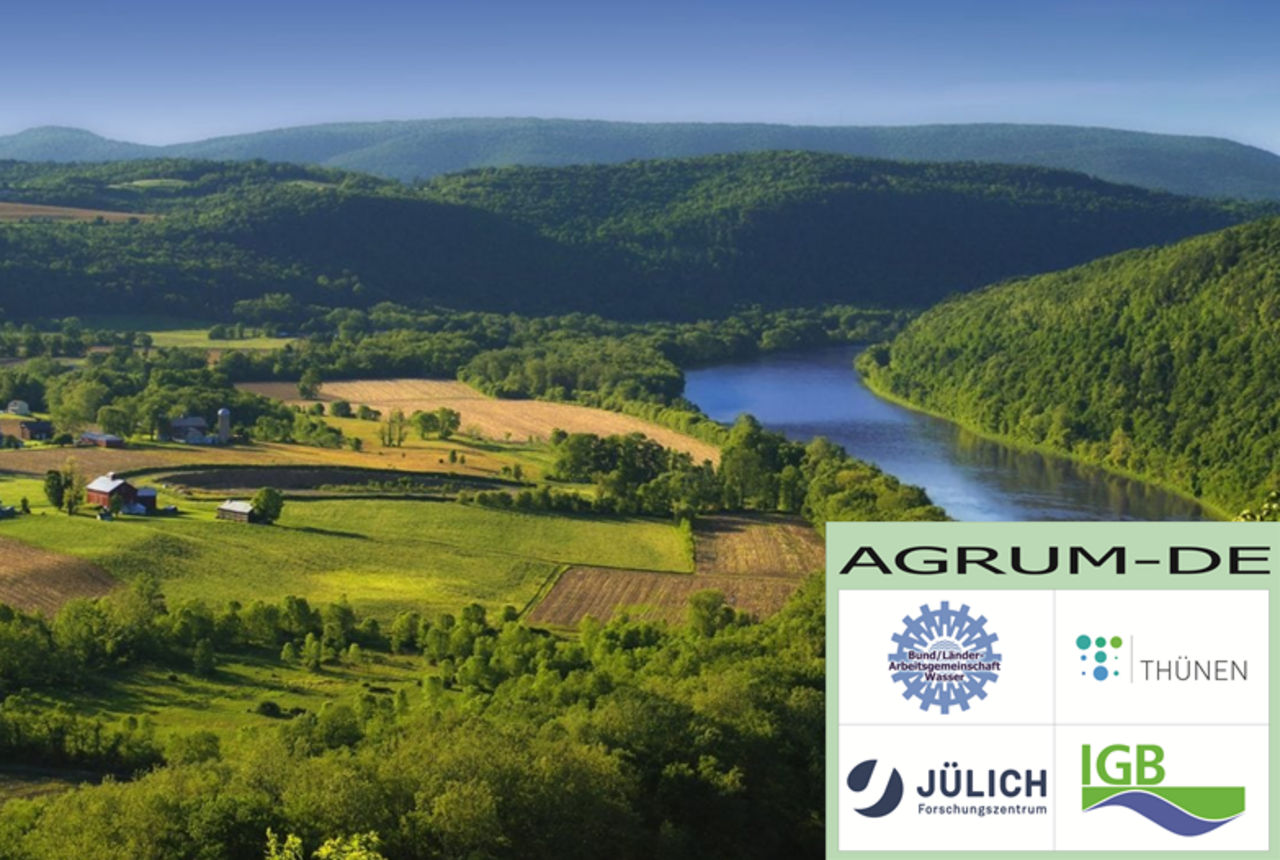Project
AGRUM Germany

AGRUM-DE – Analysis of Agricultural and Environmental Measures in the context of agricultural water protection against the background of the EU Water Framework Directive in Germany
The objectives of the EU- Water Framework Directive have not yet been fully achieved in many regions of Germany. This is due in particular to diffuse nutrient inputs from agriculture. "AGRUM-DE", will therefore create a nationwide, consistent method to monitor nitrogen emissions to water bodies. Based on this, measures for better water quality are derived and their impacts will be assessed.
Background and Objective
The extensive use of mineral fertilizers, intensive livestock farming and the simultaneous accumulation of farmyard manure can lead to high agricultural nitrogen surpluses. Soil leaching and direct inputs from the atmosphere pollute both ground and surface waters and the oceans.
According to experts, the state of German waters has improved significantly in recent decades. Nevertheless, further efforts are necessary to ensure the implementation of the EU Nitrates Directive, the EU Water Framework Directive and the EU Marine Strategy Framework Directive.
Currently, integrated and harmonized monitoring of overall nutrient pollution of waters in Germany is lacking. Furthermore, quantitative information on the origin and spatial distribution of nitrogen and phosphorus inputs is necessary to develop effective planning measures. The overall objective of the project is to create a consistent nationwide nutrient model with the participation of agriculture and water management. This enables a) an analysis of all relevant nutrient inputs of German agriculture into ground and surface waters as well as of airborne nitrogen emissions and material flows and b) their spatially differentiated mapping. On this basis, we develop integrated solutions in the form of action scenarios that can be used to achieve national and European environmental policy goals.
Target Group
Political decision makers (federal government, Länder, district governments); chambers of agriculture, agricultural managers, environmental organizations, farmers' association, interested trade public
Approach
The project is divided into the following work packages:
- Merge, update and harmonize a single agricultural and hydrological data base.
- Couple the Regionalized Agricultural and Environmental Information System for Germany (RAUMIS) with the large-scale water budget model GROWA and the hydrogeological models WEKU and DENUZ, as well as the models MONERIS (MOdelling Nutrient Emissions in RIver Systems) and ME-Phos (path- and area-differentiated phosphor models)
- Perform model-based analyses of the actual status of nutrient inputs and determine the reduction requirements
- Model a baseline for the year 2027
- Update the measures
- Conduct impact analysis and cost estimation of different scenarios from agriculture, water management and immission control
- Preparation for the comparison of the two national model systems AGRUM and MoRE (Modeling of Regionalized Emissions) based on the different approaches and interim results
Data and Methods
The following agricultural statistical data have been acquired and merged into a data basis:
InVeKos (Integrated Management and Control System), Farm Structure Survey, Remote Sensing Data, HIT Database, Test Farm Statistics, Animal Disease Insurance Fund, Livestock Census, Fertilizer Trade, Data from the Administrative Implementation of the Fertilizer Ordinance and the Manure Transfer Ordinance (if available).
For the analyses in the project "AGRUM-DE" we develop and apply an interdisciplinary model network consisting of the regionalized agricultural-economic model RAUMIS, the hydrological / hydrogeological models GROWA / WEKU / DENUZ as well as the nutrient emission model MONERIS and the phosphor model ME-Phos.
New data is not collected in the project.
Our Research Questions
- What are the current regional nitrogen and phosphorus inputs into surface waters and groundwater in Germany, in river basin districts and their sub-areas?
- What is the current need for reductions in nitrogen and phosphorus inputs into the river basin districts and their sub-areas in Germany?
- How does the amended Fertilizer Ordinance affect the nitrogen and phosphorus surpluses and thus indirectly the nutrient inputs into groundwater and the oceans?
- What are the prognoses for target achievement for ground and surface water bodies?
- Which efficient combinations of measures can be applies regionally?
- How can policies to reduce nutrient inputs be better developed?
Preliminary Results
With the AGRUM-DE model network, a uniform nationwide model system has been developed, coordinated with the federal states, to map regional nutrient flows. This tool can be used to obtain information that can be used to fulfill reporting obligations under the Water Framework Directive and the Nitrates Directive, among others. The results have also contributed to the improvement of national climate reporting.
A key result of our work is the ex-ante impact assessment of the measures of the Fertilizer Ordinance 2020 on agricultural nitrogen budgets and the reduction requirements. It shows that the Fertilizer Application Ordinance - provided that the regulations are actually complied with - helps to meet the water quality targets for nitrogen in large parts of Germany.
The AGRUM-DE model network will be used in future as part of the impact monitoring of the Fertilizer Application Ordinance. The work will be continued in the RELAS project.
Thünen-Contact

Involved Thünen-Partners
Involved external Thünen-Partners
-
Forschungszentrum Jülich
(Jülich, Deutschland) -
Leibniz-Institut für Gewässerökologie und Binnenfischerei (IGB)
(Berlin, Deutschland) - Niedersächsischer Landesbetrieb für Wasserwirtschaft, Küsten- und Naturschutz (NLWKN)
(Norden, Deutschland) -
Bund/Länder-Arbeitsgemeinschaft Wasser (LAWA)
(Jena, Deutschland) -
Flussgebietsgemeinschaft Weser
(Hildesheim, Deutschland) -
MELUND SH
(Kiel, Deutschland)
Duration
10.2018
More Information
Project status:
ongoing
Publications to the project
- 0
Schmidt B, Eysholdt M, Fischer M, Kreins P, Krüger A, Kunkel R, Nguyen HH, Tetzlaff B, Trepel M, Venohr M, Wendland F, Wolters T, Zinnbauer M (2024) AGRUM-DE als gemeinsames Instrument der Land- und Wasserwirtschaft für die bundesweite Nährstoffmodellierung. Hydrol Wasserbewirtsch 68(1):6-22, DOI:10.5675/HyWa_2024.1_1
- 1
Tetzlaff B, Kunkel R, Eysholdt M, Nguyen HH, Venohr M, Wolters T, Zinnbauer M, Wendland F (2024) Modelling current-state N- and P-fluxes into surface waters in Germany. Water 16(13):1872, DOI:10.3390/w16131872
- 2
Zinnbauer M, Brandes E, Eysholdt M, Henseler M, Löw P (2024) Modelling high resolution agricultural nitrogen budgets: A case study for Germany. Water 16(17):2376, DOI:10.3390/w16172376
- 3
Eysholdt M, Kunkel R, Rösemann C, Wendland F, Wolters T, Zinnbauer M, Fuß R (2022) A model-based estimate of nitrate leaching in Germany for GHG reporting. J Plant Nutr Soil Sci 185(6):850-863, DOI:10.1002/jpln.202200119
- 4
Schmidt B, Kuhn U, Trepel M, Fischer M, Krüger A, Kreins P, Zinnbauer M, Eysholdt M, Wendland F, Kunkel R, Tetzlaff B, Wolters T, Venohr M, Nguyen HH (2022) Bestimmung der Nährstoffbelastung und des Handlungsbedarfs in den deutschen Flussgebieten. Wasser Abfall(22):22-30
- 5
Zinnbauer M, Eysholdt M, Kreins P (2020) Erstellung und Analyse räumlich hochaufgelöster Nährstoffbilanzen in AGRUM Deutschland: Grundstein für einen Wandel im landwirtschaftlichen Gewässerschutz? Schr Gesellsch Wirtsch Sozialwiss Landbaues 55:411-413
- 6
Schmidt B, Kuhn U, Trepel M, Kreins P, Zinnbauer M, Eysholdt M, Osterburg B, Löw P, Wendland F, Herrmann F, Kunkel R, Tetzlaff B, Wolters T, Venohr M, Nguyen H (2020) Modellansatz zur Bestimmung der Nährstoffbelastung und ihrer Reduktion in allen deutschen Flussgebieten. Wasser Abfall 22(1-2):33-38
Further publications to the project
Model network AGRUM-DE:
- Schmidt B, Kuhn U, Trepel M, Kreins P, Zinnbauer M, Eysholdt M, Osterburg B, Löw P, Wendland F, Herrmann F, Kunkel R, Tetzlaff B, Wolters T, Venohr M, Nguyen H (2020)
Modellansatz zur Bestimmung der Nährstoffbelastung und ihrer Reduktion in allen deutschen Flussgebieten.
Wasser Abfall 22(1-2):33-38
Data and methods in AGRUM-DE:
Thünen-Institut:
• (upcoming)
Forschungszentrum Jülich:
• AGRUM-DE – Modellbeschreibung (mGROWA-DENUZ-WEKU-MEPHOS)
pdf document (limited accessibility) 1957 kb
Institut für Binnenfischerei und Gewässerökologie Berlin:
• (upcoming
About the AGRUM approach:
- Ackermann A, Heidecke C, Hirt U, Kreins P, Kuhr P, Kunkel R, Mahnkopf J, Schott M, Tetzlaff B, Venohr M, Wendland F (2015) Der Modellverbund AGRUM als Instrument zum landesweiten Nährstoffmanagement in Niedersachsen. Braunschweig: Johann Heinrich von Thünen-Institut, 314 p, Thünen Rep 37, DOI:10.3220/REP1450256145000
pdf document (limited accessibility) 13733 kb - Heidecke C, Hirt U, Kreins P, Kuhr P, Kunkel R, Mahnkopf J, Schott M, Tetzlaff B, Venohr M, Wagner A, Wendland F (2015) Endbericht zum Forschungsprojekt "Entwicklung eines Instrumentes für ein flussgebietsweites Nährstoffmanagement in der Flussgebietseinheit Weser" AGRUM+-Weser. Braunschweig: Johann Heinrich von Thünen-Institut, 380 p, Thünen Rep 21, DOI:10.3220/REP_21_2015
pdf document (limited accessibility) 9537 kb
Other publications about the model network AGRUM and about the single models:
- List of publications
pdf document (limited accessibility) 765 kb






